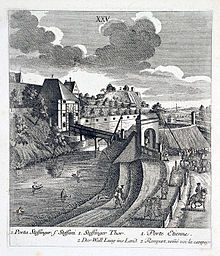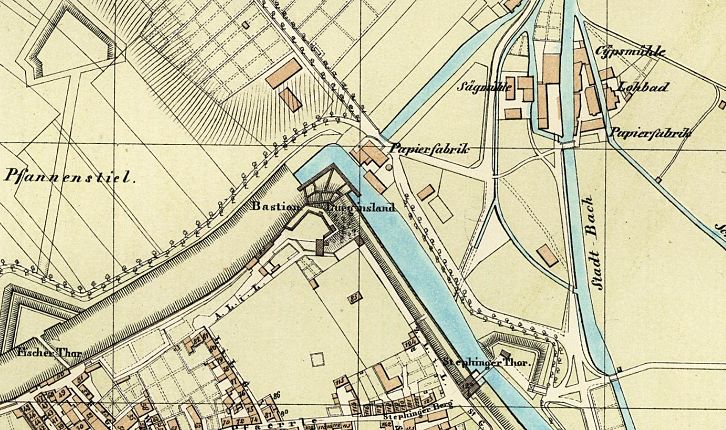Lueginsland
The Lueginsland (formerly also Luginsland ) is a fortress of the former city fortifications that has been preserved to this day on the northeastern edge of Augsburg city center in the district of Bleich und Pfärrle . Originally there was a tower there from 1430 to observe the surrounding area. In the middle of the 16th century, it was expanded into a bastion . After the fortress status of Augsburg was lifted in 1866, the complex was partially preserved and has been renovated several times up to the present. The building is registered as a monument in the Bavarian List of Monuments .
The name "Lueginsland" goes back to the word lugen , which means "to keep an eye out".
history

On the advice of Emperor Sigismund of Luxembourg in 1430, the city first built an eight-story observation tower for 6,000 guilders by 1438. At the end of the 15th century, however, it was destroyed again by a fire sparked by lightning. In 1515 it was rebuilt based on a wooden model by Adolf Daucher the Elder. Ä.
Between 1532 and 1533 the tower, again damaged by lightning, was demolished and the construction of a bastion started instead. In several construction phases, the structure was finally completed by 1553 and equipped with up to 21 cannons .
On the orders of the French troops who holed up in Augsburg during the War of the Spanish Succession around 1704, the complex was re-fortified and expanded into a citadel . In the years 1705 to 1707, however, the extensions were removed again.
In 1866 Augsburg's fortress status was abolished, so that the Lueginsland bastion also lost its importance. After part of the facility was dismantled, the rest was left to its own devices. Due to acute dilapidation, extensive renovation work began in 1915. In this context, the city also converted the facility into a publicly accessible green area. During the Second World War, an old cannon tunnel served the population as an air raid shelter .
In the post-war period, in the mid-1950s and in the 1980s, further renovation measures were carried out to maintain the facility and at the same time the area was made accessible with stairs and paths. The last masonry renovation took place between 2015 and 2016.
literature
- Günther Grünsteudel among others: Augsburger Stadtlexikon. 2nd Edition. Perlach-Verlag, 1998, ISBN 3-922769-28-4 , pp. 621-622.
- Hermann Kießling: towers - gates - bastions . Brigitte Settele Verlag, Augsburg 1987, DNB 942944631 , pp. 80-83.
- Roswitha Mitulla: Walk through old Augsburg . Presse-Druck- und Verlags GmbH Augsburg , 1985, OCLC 781053801 , p. 101.
Individual evidence
- ↑ List of monuments for Augsburg (PDF) at the Bavarian State Office for Monument Preservation, monument number D-7-61-000-47
- ↑ Digital dictionary of the German language "lugen"
- ↑ For the reconstruction project of the tower, three wooden models were made in 1514, two of which have been lost since 1945, but one is exhibited in the Augsburg municipal art collection. The model made by Daucher is the oldest surviving Renaissance architectural model in Germany.
- ↑ Hans Reuther, Ekhart Berckenhagen: German architectural models . Project aid between 1500 and 1900. Berlin 1994, ISBN 3-87157-166-0 . Catalog number 31 (Municipal Art Collections Augsburg Inv.-No. 3444, lost since 1945), 32 (Municipal Art Collections Augsburg Inv.-No. 3445, lost since 1945), 33 (Municipal Art Collections Augsburg Inv.-No. 3448, preserved )
- ^ The bastion Lueginsland. In: Augsburger Allgemeine . December 3, 2015, accessed May 25, 2017.
- ↑ City of Augsburg: Open Monument Day 2016 (PDF file; 10.1 MB)
Web links
Coordinates: 48 ° 22 '44.2 " N , 10 ° 53' 50.4" E

